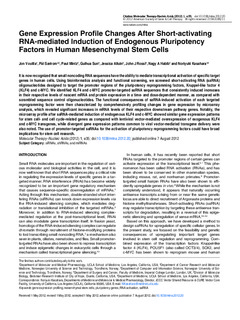| dc.contributor.author | Voutila, J | |
| dc.contributor.author | Sætrom, Pål | |
| dc.contributor.author | Mintz, Paul J | |
| dc.contributor.author | Sun, Guihua | |
| dc.contributor.author | Alluin, Jessica | |
| dc.contributor.author | Rossi, JJ | |
| dc.contributor.author | Habib, Nagy A. | |
| dc.contributor.author | Kasahara, N. | |
| dc.date.accessioned | 2019-10-16T15:27:26Z | |
| dc.date.available | 2019-10-16T15:27:26Z | |
| dc.date.created | 2012-12-12T18:57:41Z | |
| dc.date.issued | 2012 | |
| dc.identifier.citation | Molecular Therapy - Nucleic Acids. 2012, 1 (8), . | nb_NO |
| dc.identifier.issn | 2162-2531 | |
| dc.identifier.uri | http://hdl.handle.net/11250/2622648 | |
| dc.description.abstract | It is now recognized that small noncoding RNA sequences have the ability to mediate transcriptional activation of specific target genes in human cells. Using bioinformatics analysis and functional screening, we screened short-activating RNA (saRNA) oligonucleotides designed to target the promoter regions of the pluripotency reprogramming factors, Kruppel-like factor 4 (KLF4) and c-MYC. We identified KLF4 and c-MYC promoter-targeted saRNA sequences that consistently induced increases in their respective levels of nascent mRNA and protein expression in a time- and dose-dependent manner, as compared with scrambled sequence control oligonucleotides. The functional consequences of saRNA-induced activation of each targeted reprogramming factor were then characterized by comprehensively profiling changes in gene expression by microarray analysis, which revealed significant increases in mRNA levels of their respective downstream pathway genes. Notably, the microarray profile after saRNA-mediated induction of endogenous KLF4 and c-MYC showed similar gene expression patterns for stem cell- and cell cycle-related genes as compared with lentiviral vector-mediated overexpression of exogenous KLF4 and c-MYC transgenes, while divergent gene expression patterns common to viral vector-mediated transgene delivery were also noted. The use of promoter-targeted saRNAs for the activation of pluripotency reprogramming factors could have broad implications for stem cell research. | nb_NO |
| dc.language.iso | eng | nb_NO |
| dc.publisher | Elsevier | nb_NO |
| dc.rights | Attribution-NonCommercial-NoDerivatives 4.0 Internasjonal | * |
| dc.rights.uri | http://creativecommons.org/licenses/by-nc-nd/4.0/deed.no | * |
| dc.title | Gene expression profile changes after short-activating RNA-mediated induction of endogenous pluripotency factors in human mesenchymal stem cells | nb_NO |
| dc.type | Journal article | nb_NO |
| dc.type | Peer reviewed | nb_NO |
| dc.description.version | publishedVersion | nb_NO |
| dc.source.pagenumber | 13 | nb_NO |
| dc.source.volume | 1 | nb_NO |
| dc.source.journal | Molecular Therapy - Nucleic Acids | nb_NO |
| dc.source.issue | 8 | nb_NO |
| dc.identifier.doi | 10.1038/mtna.2012.20 | |
| dc.identifier.cristin | 972221 | |
| dc.description.localcode | Copyright © 2012 American Society of Gene & Cell Therapy. Published by Elsevier Inc. Attribution-NonCommercial-NoDerivs 3.0 Unported (CC BY-NC-ND 3.0) | nb_NO |
| cristin.unitcode | 194,63,10,0 | |
| cristin.unitcode | 194,65,15,0 | |
| cristin.unitname | Institutt for datateknologi og informatikk | |
| cristin.unitname | Institutt for klinisk og molekylær medisin | |
| cristin.ispublished | true | |
| cristin.fulltext | original | |
| cristin.qualitycode | 1 | |

